Energy Generation
电是如何产生的英语作文
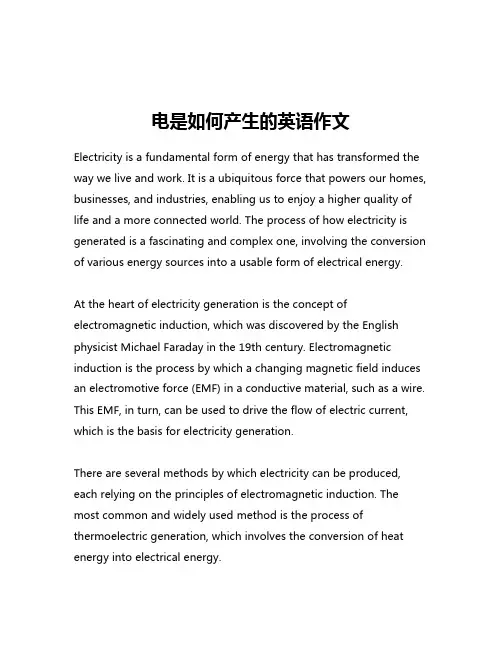
电是如何产生的英语作文Electricity is a fundamental form of energy that has transformed the way we live and work. It is a ubiquitous force that powers our homes, businesses, and industries, enabling us to enjoy a higher quality of life and a more connected world. The process of how electricity is generated is a fascinating and complex one, involving the conversion of various energy sources into a usable form of electrical energy.At the heart of electricity generation is the concept of electromagnetic induction, which was discovered by the English physicist Michael Faraday in the 19th century. Electromagnetic induction is the process by which a changing magnetic field induces an electromotive force (EMF) in a conductive material, such as a wire. This EMF, in turn, can be used to drive the flow of electric current, which is the basis for electricity generation.There are several methods by which electricity can be produced, each relying on the principles of electromagnetic induction. The most common and widely used method is the process of thermoelectric generation, which involves the conversion of heat energy into electrical energy.In a thermoelectric power plant, a fuel source, such as coal, natural gas, or nuclear energy, is used to heat water, which then turns into steam. This steam is then used to spin a turbine, which is connected to an electrical generator. As the turbine spins, it generates a changing magnetic field, which in turn induces an EMF in the generator's coils, resulting in the production of electrical current.Another method of electricity generation is hydroelectric power, which utilizes the kinetic energy of flowing water to turn turbines and generate electricity. In a hydroelectric power plant, water is stored in a reservoir behind a dam, and as the water flows through the dam, it turns the turbines, which are connected to electrical generators.Solar power is another renewable source of electricity generation, which relies on the conversion of sunlight into electrical energy. This process is known as the photovoltaic effect, where solar panels absorb sunlight and convert the energy into direct current (DC) electricity. The DC electricity is then converted into alternating current (AC) electricity, which can be used to power our homes and businesses.Wind power is another renewable source of electricity generation, where wind turbines use the kinetic energy of the wind to spin generators and produce electricity. As the wind blows, it turns theblades of the turbine, which in turn spins the generator, producing electrical current.In addition to these more well-known methods of electricity generation, there are also other emerging technologies, such as geothermal power, which uses the heat from the earth's interior to generate steam and turn turbines, and tidal power, which utilizes the energy of ocean tides to generate electricity.Regardless of the method used, the fundamental principle of electricity generation remains the same: the conversion of one form of energy, such as heat, kinetic, or solar energy, into electrical energy through the process of electromagnetic induction. This process is a testament to the ingenuity and scientific understanding of humanity, as we continue to harness the power of the natural world to improve our lives and create a more sustainable future.。
风资源评估流程及方法
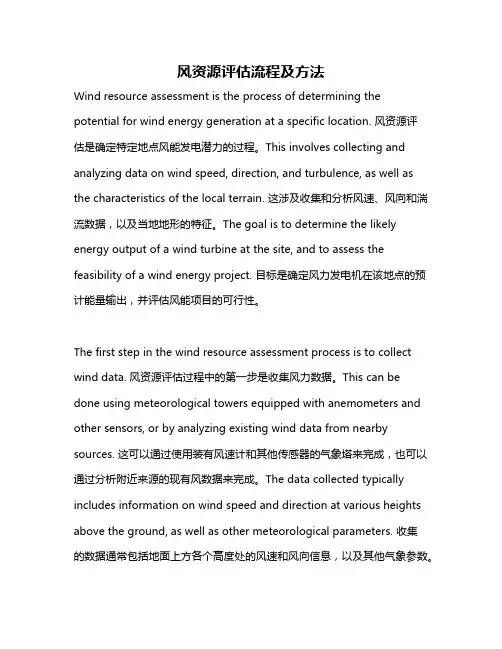
风资源评估流程及方法Wind resource assessment is the process of determining the potential for wind energy generation at a specific location. 风资源评估是确定特定地点风能发电潜力的过程。
This involves collecting and analyzing data on wind speed, direction, and turbulence, as well as the characteristics of the local terrain. 这涉及收集和分析风速、风向和湍流数据,以及当地地形的特征。
The goal is to determine the likely energy output of a wind turbine at the site, and to assess the feasibility of a wind energy project. 目标是确定风力发电机在该地点的预计能量输出,并评估风能项目的可行性。
The first step in the wind resource assessment process is to collect wind data. 风资源评估过程中的第一步是收集风力数据。
This can be done using meteorological towers equipped with anemometers and other sensors, or by analyzing existing wind data from nearby sources. 这可以通过使用装有风速计和其他传感器的气象塔来完成,也可以通过分析附近来源的现有风数据来完成。
The data collected typically includes information on wind speed and direction at various heights above the ground, as well as other meteorological parameters. 收集的数据通常包括地面上方各个高度处的风速和风向信息,以及其他气象参数。
generation表示产生的用法及短语
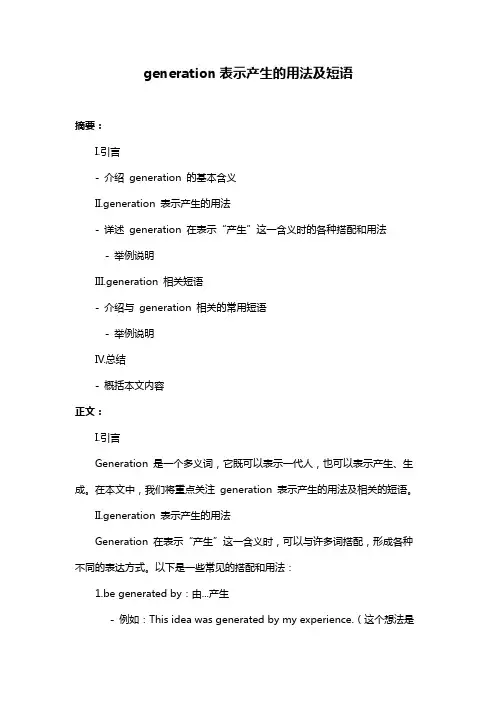
generation表示产生的用法及短语摘要:I.引言- 介绍generation 的基本含义II.generation 表示产生的用法- 详述generation 在表示“产生”这一含义时的各种搭配和用法- 举例说明III.generation 相关短语- 介绍与generation 相关的常用短语- 举例说明IV.总结- 概括本文内容正文:I.引言Generation 是一个多义词,它既可以表示一代人,也可以表示产生、生成。
在本文中,我们将重点关注generation 表示产生的用法及相关的短语。
II.generation 表示产生的用法Generation 在表示“产生”这一含义时,可以与许多词搭配,形成各种不同的表达方式。
以下是一些常见的搭配和用法:1.be generated by:由...产生- 例如:This idea was generated by my experience.(这个想法是由我的经验产生的。
)2.generate:产生,生成- 例如:The machine generates electricity.(这台机器产生电力。
)3.generation of:一代...- 例如:He is a generation of talented musicians.(他是一代才华横溢的音乐家。
)4.generate A from B:从B 生成A- 例如:This chemical reaction generates heat from energy.(这个化学反应从能量中产生热量。
)III.generation 相关短语与generation 相关的常用短语有很多,这里我们列举一些常见的:1.power generation:发电- 例如:The power plant is the main source of power generation in our city.(发电厂是我们城市的主要电力来源。
关于风能的英文文章
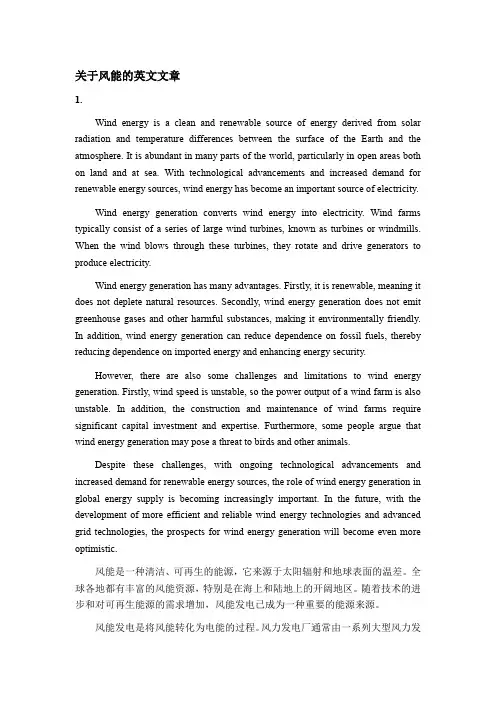
关于风能的英文文章1.Wind energy is a clean and renewable source of energy derived from solar radiation and temperature differences between the surface of the Earth and the atmosphere. It is abundant in many parts of the world, particularly in open areas both on land and at sea. With technological advancements and increased demand for renewable energy sources, wind energy has become an important source of electricity.Wind energy generation converts wind energy into electricity. Wind farms typically consist of a series of large wind turbines, known as turbines or windmills. When the wind blows through these turbines, they rotate and drive generators to produce electricity.Wind energy generation has many advantages. Firstly, it is renewable, meaning it does not deplete natural resources. Secondly, wind energy generation does not emit greenhouse gases and other harmful substances, making it environmentally friendly. In addition, wind energy generation can reduce dependence on fossil fuels, thereby reducing dependence on imported energy and enhancing energy security.However, there are also some challenges and limitations to wind energy generation. Firstly, wind speed is unstable, so the power output of a wind farm is also unstable. In addition, the construction and maintenance of wind farms require significant capital investment and expertise. Furthermore, some people argue that wind energy generation may pose a threat to birds and other animals.Despite these challenges, with ongoing technological advancements and increased demand for renewable energy sources, the role of wind energy generation in global energy supply is becoming increasingly important. In the future, with the development of more efficient and reliable wind energy technologies and advanced grid technologies, the prospects for wind energy generation will become even more optimistic.风能是一种清洁、可再生的能源,它来源于太阳辐射和地球表面的温差。
雅思作文法国发电能源
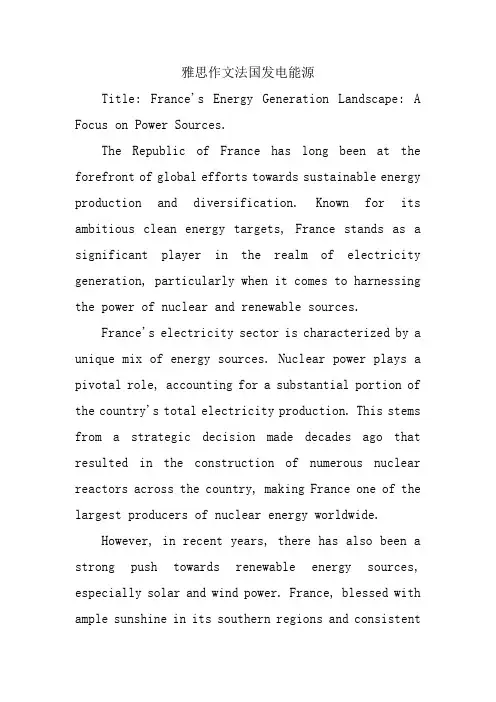
雅思作文法国发电能源Title: France's Energy Generation Landscape: A Focus on Power Sources.The Republic of France has long been at the forefront of global efforts towards sustainable energy production and diversification. Known for its ambitious clean energy targets, France stands as a significant player in the realm of electricity generation, particularly when it comes to harnessing the power of nuclear and renewable sources.France's electricity sector is characterized by a unique mix of energy sources. Nuclear power plays a pivotal role, accounting for a substantial portion of the country's total electricity production. This stems from a strategic decision made decades ago that resulted in the construction of numerous nuclear reactors across the country, making France one of the largest producers of nuclear energy worldwide.However, in recent years, there has also been a strong push towards renewable energy sources, especially solar and wind power. France, blessed with ample sunshine in its southern regions and consistentcoastal winds, has seen considerable growth in solar photovoltaic installations and wind farms. The government's commitment to reducing carbon emissions and transitioning away from fossil fuels has led to increased investments in these sectors, turning France into a solar power giant as well.In addition to this, hydroelectric power remains an essential contributor to the French energy grid due to the nation's numerous rivers and dams. Biomass and geothermal energy also play a part in France's diversified energy portfolio.标题:法国电力生产概览-聚焦能源来源。
可再生能源英语
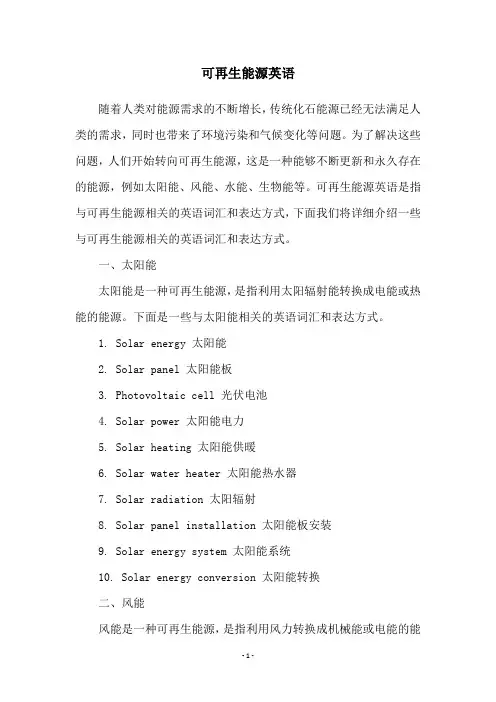
可再生能源英语随着人类对能源需求的不断增长,传统化石能源已经无法满足人类的需求,同时也带来了环境污染和气候变化等问题。
为了解决这些问题,人们开始转向可再生能源,这是一种能够不断更新和永久存在的能源,例如太阳能、风能、水能、生物能等。
可再生能源英语是指与可再生能源相关的英语词汇和表达方式,下面我们将详细介绍一些与可再生能源相关的英语词汇和表达方式。
一、太阳能太阳能是一种可再生能源,是指利用太阳辐射能转换成电能或热能的能源。
下面是一些与太阳能相关的英语词汇和表达方式。
1. Solar energy 太阳能2. Solar panel 太阳能板3. Photovoltaic cell 光伏电池4. Solar power 太阳能电力5. Solar heating 太阳能供暖6. Solar water heater 太阳能热水器7. Solar radiation 太阳辐射8. Solar panel installation 太阳能板安装9. Solar energy system 太阳能系统10. Solar energy conversion 太阳能转换二、风能风能是一种可再生能源,是指利用风力转换成机械能或电能的能源。
下面是一些与风能相关的英语词汇和表达方式。
1. Wind energy 风能2. Wind turbine 风力涡轮机3. Wind farm 风电场4. Wind power 风力发电5. Wind speed 风速6. Wind direction 风向7. Wind energy conversion 风能转换8. Wind energy system 风能系统9. Wind energy generation 风能发电10. Wind energy installation 风能设备安装三、水能水能是一种可再生能源,是指利用水流或水位高差转换成机械能或电能的能源。
下面是一些与水能相关的英语词汇和表达方式。
八下英语仁爱u5t1的重点单词
八下英语仁爱u5t1的重点单词Unit 5 Topic 1 的重点单词如下:1. pollution (n.) - 污染Pollution refers to the presence of harmful or toxic substances in the environment, especially in the air, water, or soil. Industrial activities and the burning of fossil fuels are major sources of pollution.2. environment (n.) - 环境Environment refers to the surroundings or conditions in which a person, animal, or plant lives. It includes both natural and artificial elements, such as the air, water, land, buildings, and other living organisms.3. global (adj.) - 全球的Global means worldwide or relating to the entire Earth. It is often used to describe issues or problems that affect everyone on the planet, regardless of their location or nationality.4. solve (v.) - 解决Solve means to find a solution or answer to a problem. When faced with a challenge or difficulty, people try to solve it by coming up with ideas or strategies to overcome it.5. solution (n.) - 解决方案Solution refers to an answer or method to solve a problem. It usually involves a series of steps or actions that can lead to the desired outcome or resolution of the issue.6. recycle (v.) - 回收利用Recycle means to convert waste materials into reusable items. Recycling helps to reduce the amount of waste produced and preserves natural resources by using them more efficiently.7. waste (n.) - 废物Waste refers to any unwanted or unusable materials, substances, or products. It includes things like garbage, trash, or byproducts of manufacturing processes.8. reduce (v.) - 减少Reduce means to make something smaller or less in size, amount, orintensity. It is often used in the context of environmental conservation to encourage people to decrease their consumption or waste.9. reuse (v.) - 再使用Reuse means to use an item or object again, either for its original purpose or in a different way. By reusing items, people can extend their lifespan and minimize the need for new production.10. resource (n.) - 资源Resource refers to any material or asset that can be used to fulfill a need or achieve a goal. It can include natural resources like water, oil, or minerals, as well as human resources such as skills or knowledge.11. source (n.) - 来源Source refers to the origin or point of supply of something. It is often used to describe where something comes from or where it can be obtained.12. energy (n.) - 能源Energy is the ability or capacity to do work. It can be in various forms, such as thermal, electrical, or mechanical energy, and is vital for powering machines, vehicles, and other devices.13. generation (n.) - 一代人Generation refers to a group of individuals born and living at the same time. It can also refer to the act or process of producing or creating something.14. renewable (adj.) - 可再生的Renewable means capable of being replenished or replaced naturally within a relatively short period of time. Renewable energy sources, such as solar or wind power, can be used without depleting the Earth's limited resources.15. fossil fuel (n.) - 化石燃料Fossil fuel refers to any hydrocarbon deposit, such as coal, oil, or natural gas, formed from the remains of ancient plants and animals. Fossil fuels are non-renewable resources and contribute to pollution and climate change when burned.16. solar (adj.) - 太阳的Solar means relating to or derived from the sun. Solar energy isobtained from sunlight and can be converted into usable electricity or heat through various technologies.17. wind (n.) - 风Wind refers to the natural movement of air, especially a current ofair blowing from a particular direction. Wind energy is harnessed by wind turbines to generate electricity.18. hydroelectric (adj.) - 水力发电的Hydroelectric means generating electricity through the use of flowing or falling water. Hydroelectric power plants convert the kinetic energy of water into electrical energy.19. biofuel (n.) - 生物燃料Biofuel refers to a renewable fuel derived from recently living biological materials, such as plants or animal waste. It can be used as an alternative to fossil fuels in vehicles or for heating.20. nuclear (adj.) - 核能的Nuclear means relating to or using atomic energy. Nuclear power plants generate electricity by harnessing the energy released from nuclear reactions, such as the splitting of atoms.21. carbon (n.) - 碳Carbon is a chemical element that is present in all living organisms and many minerals. It is also a major component of fossil fuels, and the release of carbon dioxide into the atmosphere is a significant contributor to climate change.22. dioxide (n.) - 二氧化物Dioxide is a chemical compound that contains two oxygen atoms and one other atom. Carbon dioxide (CO2) is a common dioxide and a byproduct of burning fossil fuels.23. footprint (n.) - 碳足迹Carbon footprint is a measure of the impact of human activities on the environment, particularly the amount of greenhouse gases produced, especially carbon dioxide, as a result of consuming resources and energy.24. emission (n.) - 排放Emission refers to the release of gas, particles, or radiation into the atmosphere. Carbon emissions, for example, are a major concern due totheir role in global warming.25. alternative (adj.) - 可替代的Alternative means available as a substitute for something else. In the context of energy and resources, alternatives are often sought to reduce reliance on non-renewable or environmentally harmful options.26. sustainable (adj.) - 可持续的Sustainable means able to be maintained or kept going over a long period of time. Sustainable practices aim to protect the environment, economy, and social well-being without depleting resources.27. conservation (n.) - 保护Conservation is the act of protecting and preserving natural resources and habitats. It involves managing resources in a way that they can be used sustainably while maintaining their natural integrity.28. efficiency (n.) - 效率Efficiency is the ability to do something without wasting materials, time, or energy. Improving efficiency is crucial for reducing waste and minimizing the environmental impact of various activities.29. green (adj.) - 绿色的Green can refer to anything related to environmental conservation and sustainability. "Going green" means adopting practices that are friendly to the environment, such as using renewable energy or reducing waste.30. climate (n.) - 气候Climate is the usual kind of weather in a particular place or region. Climate change refers to long-term shifts in weather patterns and is often associated with human activities that emit greenhouse gases.31. change (n./v.) - 变化Change refers to the act or instance of making or becoming different. Climate change is one of the most pressing global issues, requiringsignificant changes in human behavior and energy use.32. action (n.) - 行动Action refers to a thing done or a process that is taking place. Taking action on climate change involves implementing policies and practices that reduce greenhouse gas emissions and adapt to a changing environment.33. responsibility (n.) - 责任Responsibility is the state or fact of having a duty to deal with something or of having control over someone. Individuals, communities, and governments all have a responsibility to protect the environment and address climate change.34. challenge (n.) - 挑战Challenge is a call to take part in a contest or competition, often involving problems to be solved. Addressing climate change and environmental pollution presents significant challenges that require innovative solutions.35. future (n.) - 未来Future refers to the time that will come after the present time. Ensuring a sustainable future involves making decisions and taking actions now that will have a positive impact on the environment and future generations.这些是 Unit 5 Topic 1中的重点单词,掌握它们将有助于理解和学习有关环境和能源的话题。
新能源 英文简介范文
新能源英文简介范文New Energy: The Future of Sustainable Development.As the world faces increasing challenges related to climate change and environmental degradation, the need for renewable and sustainable energy sources has become paramount. New energy, also known as renewable energy, refers to a range of resources that are continuously replenished by natural processes and have the potential to meet the world's energy needs without causing harmful emissions or exhausting natural resources.Types of New Energy.1. Solar Energy: Solar energy harnesses the power of the sun's radiation. Photovoltaic cells convert sunlight into electricity, while solar thermal systems capture the sun's heat for use in heating, cooling, and other applications.2. Wind Energy: Wind turbines convert the kinetic energy of the wind into electricity. With advances in turbine design and materials, wind energy has become acost-effective and reliable source of renewable power.3. Hydroelectric Energy: This form of energy harnesses the kinetic energy of moving water, either from rivers or dams, to generate electricity. Hydroelectric power plants are a long-standing renewable energy source, but their construction can have significant environmental impacts.4. Biomass Energy: Biomass refers to organic matter derived from plants or animals that can be converted into energy. This can include wood, agricultural waste, and even waste from industries. Biomass energy can be used for heating, electricity generation, and biofuels.5. Geothermal Energy: Geothermal energy taps into the heat stored within the Earth's crust. This heat can be used for heating, cooling, and electricity generation, often in the form of geothermal power plants.Advantages of New Energy.Environmental Benefits: Renewable energy sources emit far less greenhouse gases and air pollution than fossil fuels, helping to mitigate the impacts of climate change.Sustainability: New energy sources are renewable, meaning they can be replenished over time, ensuring a sustainable energy supply for future generations.Energy Security: Diversifying energy sources and reducing reliance on fossil fuels improves energy security, reducing the risk of supply interruptions and price fluctuations.Economic Growth: Investing in renewable energy creates jobs, stimulates innovation, and drives economic growth.Challenges and Solutions.Despite the many advantages of new energy, there are also challenges that need to be addressed.Intermittency: Sources like solar and wind energy are intermittent, meaning their availability can vary depending on weather conditions. To address this, energy storage systems and smart grids are being developed to balance supply and demand.Infrastructure: Building out renewable energy infrastructure requires significant investment and can be challenging in rural or remote areas. Public-private partnerships and innovative financing mechanisms can help overcome these barriers.Policy and Regulations: Favorable policies and regulations that promote renewable energy deployment and encourage innovation are crucial for its widespread adoption.Conclusion.In conclusion, new energy represents a crucial step towards a sustainable and environmentally friendly energyfuture. By harnessing the power of renewable resources like solar, wind, and geothermal energy, we can meet our energy needs while protecting the planet for future generations. While challenges remain, ongoing research, innovation, and policy reform can help us overcome these obstacles and move towards a cleaner, safer energy future.。
advanced energy materials能量效率 -回复
advanced energy materials能量效率-回复Advanced Energy Materials: Enhancing Energy EfficiencyIntroduction:In a world where the demand for energy is constantly increasing, the need for efficient energy materials has become crucial. Advanced energy materials play a significant role in improving energy efficiency and reducing environmental impact. This article aims to delve into the concept of energy efficiency and explore how advanced energy materials contribute to enhancing it.1. Understanding Energy Efficiency:Energy efficiency refers to the ability to achieve more output with less input of energy. It focuses on reducing energy waste while maintaining or even enhancing the desired outcome. Energy efficiency plays a vital role in mitigating climate change, conserving resources, and ensuring sustainable development.2. The Role of Advanced Energy Materials:Advanced energy materials act as enablers for energy efficiency improvements across different sectors. These materials possess unique properties that make them ideal for energy generation,storage, and conversion. Let's explore some key areas where advanced energy materials are making a notable difference:A. Energy Generation:Renewable energy sources such as solar, wind, and hydroelectric power rely on advanced materials for efficient energy generation. For example, new rooftop solar panels incorporate advanced photovoltaic materials that capture sunlight and convert it into electricity with high efficiency. Similarly, advanced wind turbine materials enable better energy extraction from wind resources, increasing energy generation capacity.B. Energy Storage:Efficient energy storage is crucial for balancing the intermittent nature of renewable energy sources and meeting peak demand. Advanced energy storage materials, such as lithium-ion batteries, supercapacitors, and fuel cells, have revolutionized the storage industry. These materials exhibit high energy density, fast charging capabilities, and long cycle life, enabling efficient energy capture and release.C. Energy Conversion:Converting one form of energy into another is a critical process in various applications. Advanced energy materials play a significant role in improving the efficiency of energy conversion devices. For instance, fuel cell catalyst materials enhance the efficiency of converting chemical energy to electrical energy. Additionally, thermoelectric materials allow the conversion of waste heat into electricity, reducing energy losses and improving overall efficiency.3. Advancements in Energy Materials Technology:Continuous research and innovation in advanced energy materials have led to significant advancements in their performance. Here are some notable examples:A. Nanomaterials:Nanotechnology has revolutionized the field of energy materials. Nanostructured materials, such as nanoparticles and nanocomposites, exhibit unique properties due to their small size and increased surface area. These materials enhance energy efficiency by improving energy conversion processes, reducing resistance, and enabling better control of energy flows.B. Smart Materials:Smart materials, also known as responsive or adaptive materials, change their properties in response to external stimuli. These materials can dynamically adjust their behavior to optimize energy usage. For example, shape memory alloys can recover their original shape upon heating, reducing energy loss due to deformation during operation.C. Sustainable Materials:Sustainability is a key consideration in energy materials development. Researchers are focusing on designing materials that are environmentally friendly throughout their life cycle. This includes using abundant, non-toxic, and recyclable materials. By adopting sustainable materials, energy systems can minimize their environmental footprint and ensure long-term viability.Conclusion:Advanced energy materials play a pivotal role in enhancing energy efficiency across various sectors. From energy generation to storage and conversion, these materials enable more sustainable and efficient energy usage. Continuous advancements in energy materials technology, such as nanomaterials, smart materials, andsustainable materials, further contribute to improving energy efficiency and reducing environmental impact. Embracing and fostering research in advanced energy materials is crucial for building a sustainable future energy system.。
氮气余压发电策划方案
氮气余压发电策划方案英文回答:Nitrogen Pressure Energy Generation Plan.Introduction:In recent years, there has been a growing interest in finding alternative sources of energy. One such source is nitrogen pressure, which can be harnessed to generate electricity. In this proposal, I will outline a plan for utilizing nitrogen pressure to generate electricity, providing a sustainable and eco-friendly solution for our energy needs.Background:Nitrogen is abundantly available in the atmosphere, making up about 78% of the air we breathe. Nitrogen pressure can be harnessed to generate electricity through aprocess called nitrogen pressure energy generation. This process involves compressing nitrogen gas, storing it under high pressure, and then releasing it to drive turbines, which in turn generate electricity.Implementation Plan:1. Collection and Compression:The first step in the nitrogen pressure energy generation plan is to collect nitrogen gas from the atmosphere. This can be done through air separation units or by utilizing the nitrogen-rich byproducts of industrial processes. The collected nitrogen gas is then compressed using high-pressure compressors to increase its energy potential.2. Storage:Once the nitrogen gas is compressed, it needs to be stored under high pressure. This can be achieved by using high-pressure storage tanks or by injecting the compressedgas into underground reservoirs. The stored nitrogen gas acts as a potential energy source, ready to be released and converted into electricity.3. Release and Electricity Generation:To generate electricity, the stored nitrogen gas is released through controlled valves, allowing it to expand rapidly. The expanding gas drives turbines, which are connected to generators, converting the mechanical energy into electrical energy. The generated electricity can then be used to power various applications, such as homes, industries, and transportation.Benefits:1. Renewable and Eco-friendly:Using nitrogen pressure for electricity generation is a renewable and eco-friendly solution. Nitrogen gas is abundantly available in the atmosphere and does not contribute to greenhouse gas emissions or air pollutionwhen used as an energy source.2. Cost-effective:The nitrogen pressure energy generation plan offers a cost-effective solution for electricity generation. The initial investment in infrastructure and equipment can be offset by the long-term savings in fuel costs, as nitrogen gas is freely available and does not need to be purchased.3. Versatility:Nitrogen pressure energy generation can be integrated into existing power grids, providing a versatile solution for meeting energy demands. It can be used as a standalone power source or combined with other renewable energy sources, such as solar or wind, to ensure a stable and reliable energy supply.Example:Let's consider a scenario where a nitrogen pressureenergy generation plant is implemented in a city. The compressed nitrogen gas is stored in underground reservoirs and released to drive turbines, generating electricity for the city's power grid. This electricity is then used to power homes, businesses, and public transportation systems.中文回答:氮气余压发电策划方案。
- 1、下载文档前请自行甄别文档内容的完整性,平台不提供额外的编辑、内容补充、找答案等附加服务。
- 2、"仅部分预览"的文档,不可在线预览部分如存在完整性等问题,可反馈申请退款(可完整预览的文档不适用该条件!)。
- 3、如文档侵犯您的权益,请联系客服反馈,我们会尽快为您处理(人工客服工作时间:9:00-18:30)。
- Differences in pressure gradients around wind turbines affect birds -Noise from the turbines affects people and animals -Eyesore, the appearance of mile after mile of wind machines with transmission lines is of concern to the public
Electricity by definition is electric current that is used as a power source!
This electric current is generated in a power plant, and then sent out over a power grid to your homes, and ultimately to your power outlets.
- California currently produces ¾ of all the wind generated electricity in the world.
Wind generated Kilronan Wind Farm In Ireland
-North Dakota with 20 times the wind potential of California has not erected a single wind turbine
Water generated - Hydroelectric Shasta Dam In California
- Hydroelectricity has dropped from producing 30 % to 10% of US electricity - Large fluctuations in output are mainly due to variable rainfall totals
-Conversion from potential energy of பைடு நூலகம்ater to electric energy is at 80 – 90% efficiency
-Hydroelectric projects in the United States have rated capacities from 950 – 6480 MW -The use of Water Power is much greater in some other countries. Norway obtains 99% of its electricity from water power. Nepal, Brazil, and New Zealand are close seconds.
-attains between 50 – 70% efficiency
- one windmill’s average energy output ranges from 11.4 W/m^2 – 57 W/m^2 depending on how windy -wind farms tend to generate between 50 and 600 Kw
Faraday attached two wires to a disc and rotated the disc between the opposing poles of a horseshoe magnet creating an electric current.
If you place a magnet and a conductor (copper wire), in a room together there will be no electric current generated. This is because motion, from our equation for electricity, is missing! An electric current is not generated unless the magnetic field is moving relative to the copper wire, or the copper wire is moving relative to the magnetic field.
Electric current generation - whether from fossil fuels, nuclear, renewable fuels, or other sources is usually based on the:
In September of 1831, Michael Faraday made the discovery of Electromagnetic Induction.
The electric current, running through the copper wire causes the armature to spin which is how most motors generate motion.
Where does the motion needed to keep the copper wire moving relative to the magnetic field come from?
An easier way to think of electric current is to picture cars going through a Turnpike or Parkway Toll.
The cars could represent electrons or charge, and the toll booth could represent the cross sectional area of the wire at a certain point.
If you counted the number of cars or electrons, that passed through the toll booth or a certain cross sectional area of the wire, and divided that number by the time it took for those cars or charges to pass, you would get the current!
Wind power classes 3 (300-400 W/m2) to 7 (800-2000 W/m2) are suitable for wind power development
-Wind variability must be overcome by system design
- Basic energy Storage
So simple electric generators found in power plants contain, magnets and copper wire that when put into motion relative to one another create the electric current that is sent out to homes. The major problem in electricity generation Is where does the Motion come from that keeps the copper wire and magnets moving relative to one another. In this case, wind power applies a force to the blades that turns them. The spinning blades, spin an armature that turns the copper wire relative to the magnetic field. As long as the blades spin, electricity will be generated!
Standard Large Power Plants Provide 1 Giga-watt of electric power and releases 2 Giga-watts of thermal power as waste heat. An efficiency averaging around 30%. -9000 tons of coal a day -40,000 barrels a day or one tanker a week of oil -generates about 5.3 x 10^9 kwh/year -powers a city of a million people
- AC of 60 Hz produced by generator - Resistance losses are smallest at high voltages and low currents
At home, electric current that was generated by generators in the power plant is used to power electric appliances.
The movement of charges such as electrons is called current, and this electrical current is what powers household appliances. Charge Passing Through A Given Area Electric Current = ------------------------------Time
